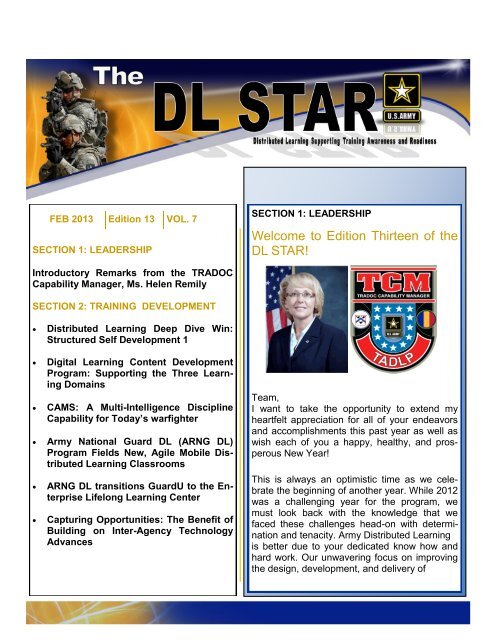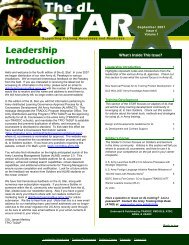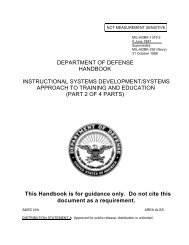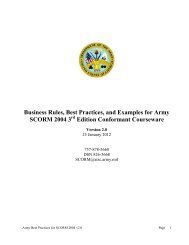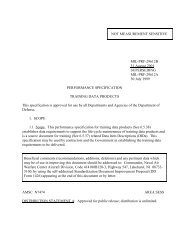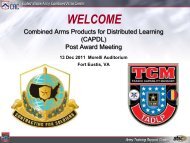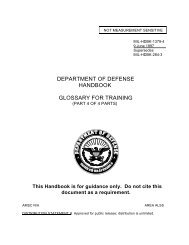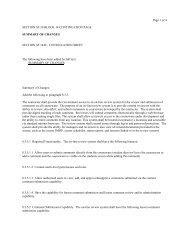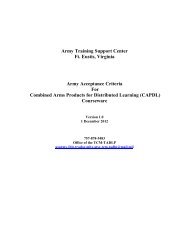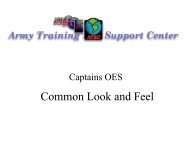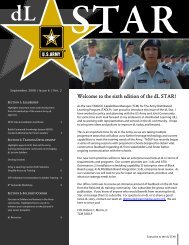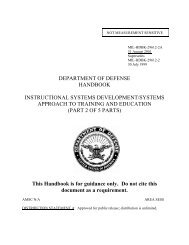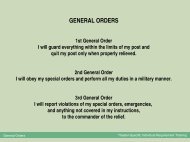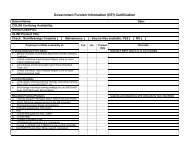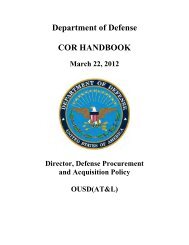Download - U. S. Army Training Support Center
Download - U. S. Army Training Support Center
Download - U. S. Army Training Support Center
Create successful ePaper yourself
Turn your PDF publications into a flip-book with our unique Google optimized e-Paper software.
FEB 2013 Edition 13 VOL. 7<br />
SECTION 1: LEADERSHIP<br />
SECTION 1: LEADERSHIP<br />
Welcome to Edition Thirteen of the<br />
DL STAR!<br />
Introductory Remarks from the TRADOC<br />
Capability Manager, Ms. Helen Remily<br />
SECTION 2: TRAINING DEVELOPMENT<br />
<br />
<br />
<br />
<br />
<br />
<br />
Distributed Learning Deep Dive Win:<br />
Structured Self Development 1<br />
Digital Learning Content Development<br />
Program: <strong>Support</strong>ing the Three Learning<br />
Domains<br />
CAMS: A Multi-Intelligence Discipline<br />
Capability for Today’s warfighter<br />
<strong>Army</strong> National Guard DL (ARNG DL)<br />
Program Fields New, Agile Mobile Distributed<br />
Learning Classrooms<br />
ARNG DL transitions GuardU to the Enterprise<br />
Lifelong Learning <strong>Center</strong><br />
Capturing Opportunities: The Benefit of<br />
Building on Inter-Agency Technology<br />
Advances<br />
Team,<br />
I want to take the opportunity to extend my<br />
heartfelt appreciation for all of your endeavors<br />
and accomplishments this past year as well as<br />
wish each of you a happy, healthy, and prosperous<br />
New Year!<br />
This is always an optimistic time as we celebrate<br />
the beginning of another year. While 2012<br />
was a challenging year for the program, we<br />
must look back with the knowledge that we<br />
faced these challenges head-on with determination<br />
and tenacity. <strong>Army</strong> Distributed Learning<br />
is better due to your dedicated know how and<br />
hard work. Our unwavering focus on improving<br />
the design, development, and delivery of
training and educational content to our Soldiers,<br />
leaders, and civilians has proven our<br />
dedication and worth to the Total Force.<br />
We are diligently working on new projects to<br />
support you. These projects include: A collaboration<br />
with the Command and General<br />
Staff College to determine the feasibility of<br />
establishing a domain other than .mil; Enhancements<br />
to the <strong>Army</strong> Learning Content<br />
Management Capability (ALCMC). Upgrades<br />
to the graphical user interface (GUI) that provide<br />
greater accessibility and discoverability of<br />
content. A re-baseline of the <strong>Army</strong> Learning<br />
Management System (ALMS) that ensures<br />
content is current and playable. The TRADOC<br />
Mobile Learning Strategy describes how learning<br />
is leveraged by technology and implementation<br />
of technology leveraged by learning.<br />
Lastly an external program evaluation of The<br />
<strong>Army</strong> Distributed Learning Program (TADLP)<br />
processes which will discover ways to improve<br />
how we support you.<br />
This edition of the DL STAR provides information<br />
on two major areas: How we are working<br />
to improve the content and Soldier interaction<br />
experience for Structured Self Development<br />
(SSD) 1 and with the learning innovation.<br />
The first article on “Structured Self Development<br />
(SSD)1” was written by Ken Crim,<br />
TADLP Joint Individual Education and <strong>Training</strong><br />
It describes how the Distributed Learning Deep<br />
Dive (DLDD) Working Group conducted a comprehensive<br />
investigation to resolve issues surrounding<br />
content, playability, delivery, and recording<br />
test score results.<br />
The second article titled “Digital Learning Content<br />
Development Program <strong>Support</strong>ing the<br />
Three Learning Domains” was written by Roy<br />
Elam, Maneuver <strong>Center</strong> of Excellence (MCoE).<br />
This article features how MCOE is developing<br />
content that supports soldiers in all three of the<br />
learning domains.<br />
The article, “CAMS: A Multi-Intelligence Discipline<br />
Capability For Today’s War Fighter” is<br />
written by Regina Albrecht, The Learning Innovation<br />
Office, U.S. <strong>Army</strong> Intelligence <strong>Center</strong><br />
of Excellence. It discusses the release<br />
and uses of their Collection Asset Management<br />
Simulator.<br />
The <strong>Army</strong> National Guard Distributed Learning<br />
Program (ARNG DL) office provided the next<br />
two articles, “The <strong>Army</strong> National Guard Distributed<br />
Learning Program Fields New Agile Mobile<br />
Distributed Learning Classrooms” and “The<br />
<strong>Army</strong> National Guard Distributed Learning Program<br />
Transitions GuardU to the Enterprise Lifelong<br />
Learning <strong>Center</strong>”.<br />
Lastly, Stephanie Hale, the Defense Ammunition<br />
<strong>Center</strong> (DAC) HAZMAT Team writes to the<br />
opportunities presented through formal,
“Capturing Opportunities, The Benefit of Building<br />
On Inter-Agency Technology Advances.”<br />
All the articles reiterate the TADLP focus—to<br />
provide Soldiers, leaders, and <strong>Army</strong> civilians<br />
persistent access to the highest-quality formal<br />
and informal training and education products<br />
and DL content in support of individual, institutional,<br />
and self-development domains. We<br />
continue to strive to establish a technologyenabled<br />
learning environment where training<br />
and education content is easily discoverable,<br />
accessible, playable, flexible, and trackable<br />
through multiple delivery means.<br />
We encourage you to visit the TADLP website<br />
and join our Facebook and Intelink blog. We<br />
designed these sites to capture your knowledge<br />
and share it with other members of the<br />
DL community, so please use these tools to<br />
share your opinions or ask questions.<br />
If you have any questions about this edition or<br />
would like to submit an article for the next edition<br />
of the DL STAR, please contact us @<br />
u s a r m y . j b l e . t r a d o c . m b x . a t s c - t c m -<br />
tadlp@mail.mil.<br />
We are proud to serve and support!<br />
Helen A. Remily<br />
TRADOC Capability Manager<br />
The <strong>Army</strong> Distributed Learning Program<br />
<strong>Army</strong> E Learning Correspondence Courses –<br />
Preparing For Your Future<br />
www.us.army.mil; Select Self Service and then<br />
My Education<br />
The <strong>Army</strong> <strong>Training</strong> Network (ATN) is a single<br />
web-based portal for <strong>Army</strong> training resources.<br />
http://www.train.army.mil/<br />
The ADL Initiative was established in 1997 to<br />
standardize and modernize training and education<br />
management and delivery and is part of the<br />
Department of Defense Office of the Deputy Assistant<br />
Secretary of Defense (Readiness).
SECTION 2: TRAINING DEVELOPMENT<br />
Distributed Learning Deep Dive Win:<br />
Structured Self Development 1<br />
You have been directed to take mandatory<br />
online training by your superiors. This is important<br />
because your ability to get promoted is<br />
directly affected by the successful completion<br />
of this training. Not a problem you say. You<br />
set aside the proper amount of time to tackle<br />
the assignment, get a nice cup of coffee to get<br />
the cognitive juices flowing, and then sit down<br />
at your computer. You begin by inserting your<br />
CAC card and navigating to the <strong>Army</strong> Learning<br />
Management System through AKO. It is here<br />
that you encounter your first problem. After<br />
entering “SSD1” into the search criteria you<br />
cannot find the course. After way too much<br />
wasted time, you call the Help Desk but are<br />
quickly put on hold. So you call a battle buddy<br />
you know took the course to get his help. Your<br />
buddy comes through and now you find the<br />
course and begin the registration/enrolling<br />
process but it keeps rejecting you and not recognizing<br />
you. How can it not recognize you?<br />
Again you call the Help Desk because your<br />
friend who took the course is on leave. Finally<br />
you get registered and begin the course only<br />
to run into computer freezes, video issues,<br />
rollup issues, and bookmarking issues. Once<br />
again you call the Help Desk. Finally you finish<br />
the course, take the exam but your score does<br />
not show up in your electronic training record<br />
as completed. Into the breach once more, you<br />
call the Help Desk. Just to take one course required<br />
way too much wasted time because of<br />
those infernal computer glitches and required<br />
multiple Help Desk calls at every point of the<br />
way, sometimes not even being able to talk to<br />
someone. All you wanted to do was step forth<br />
smartly and take the required course. Now multiply<br />
that by thousands and thousands of Soldiers<br />
in that exact situation. That was the case<br />
with the requirement for Soldiers to complete<br />
Structured Self Development 1(SSD1) as a requirement<br />
for entry to the Warrior Leader<br />
Course (WLC).<br />
So what is a Soldier and thousands of his battle<br />
buddies to do? You take it up the chain. As<br />
problems in SSD1 began to surface, the TRA-<br />
DOC Capability Manager-The <strong>Army</strong> Distributed<br />
Learning Program (TCM-TADLP) took charge<br />
to find out what the problems were and how<br />
could they be fixed. TCM-TADLP took a “Deep<br />
Dive”, working with the <strong>Army</strong> <strong>Training</strong> <strong>Support</strong><br />
<strong>Center</strong> Commander, TRADOC G6, the Program<br />
Director-Distributed Learning System (PD<br />
-DLS), and the <strong>Army</strong> <strong>Training</strong> Help Desk<br />
(ATHD). These organizations began a comprehensive<br />
look at all facets of the course from the<br />
content through the delivery and accountability<br />
processes. The goal of the SSD1 DL Deep Dive<br />
(DLDD) was to assure that four key areas were<br />
working for the soldier:
Discoverability: the simple ability to<br />
easily locate the required course.<br />
Accessibility: ease of enrolling/<br />
registering for the course.<br />
Playability: executing the SSD1 courseware<br />
properly as well as the online testing.<br />
Trackability: identifying lesson and testing<br />
completions for the soldier.<br />
There was one more key player involved to<br />
make all this happen: the Soldier. TCM-<br />
TADLP did not want to work in the vacuum of<br />
its own technological resources as well as<br />
those of its other partners. They wanted to<br />
also work directly with the Soldier to see what<br />
was wrong; fix it; track those fixes by testing<br />
them with the Soldiers; if not one hundred percent<br />
happy with the fixes, continue with the<br />
process until a suitable product was available<br />
to the Soldier not only to use, but more importantly,<br />
to learn from and set the Soldier up for<br />
success in the next phase, WLC. At the same<br />
time the <strong>Army</strong> <strong>Training</strong> Help Desk (ATHD)<br />
would develop a robust capability to respond<br />
to Soldier challenges 24/7 in a thorough and<br />
expeditious manner. Additionally, PD-DLS<br />
would move all of it courses from its Ft Eustis<br />
hub to the Acquisition Logistics and Technology<br />
Enterprise System and Services<br />
(ALTESS) hub in Radford, Virginia (which it<br />
successfully accomplished over a weekend in<br />
Nov 12 as well as an update of the SSD1<br />
course incorporating all of the changes<br />
developed by the DLDD team and the Soldiers<br />
themselves). So how did they do it?<br />
TCM-TADLP worked with the Institute for Non-<br />
Commissioned Officer Professional Development<br />
(INCOPD) and the United States Sergeants<br />
Major Academy (USASMA) on the<br />
course content and curriculum issues. TCM<br />
concurrently worked with PD-DLS and the<br />
course development contractors on the technical<br />
issues side of the equation. Then throughout<br />
the process, TCM-TADLP set up a series of<br />
Soldier Limited Users Tests (LUTs) to analyze<br />
what needed fixing and evaluate if the fixes<br />
were working and met Soldiers’ expectations<br />
and learning needs in an efficient and time sensitive<br />
manner. During this period, ATHD was<br />
working on being more responsive to Help Desk<br />
queries. LUTs were set up at: Ft Campbell (Apr<br />
12); Ft Gordon (May 12); Ft Eustis (Jun 12); Ft<br />
Bliss (Jul 12); Ft Hood (Aug 12); and a final<br />
LUT scheduled for Feb 13 at Ft Carson. The<br />
Soldiers’ input was a key barometer for the<br />
technical team to gauge whether the technical<br />
adjustments and fixes were meeting the needs<br />
of the Soldiers. By the Ft Hood LUT, Soldiers<br />
found that the ability to find, register, take, and<br />
complete courses was both intuitive and easily<br />
navigated. The final LUT at Ft Carson will<br />
evaluate a few minor changes as well as the<br />
addition of one final lesson at the end of SSD1.<br />
In the meantime the ATHD worked on how to
properly and efficiently respond to thousands<br />
of Help Desk (HD) tickets as well as become a<br />
24/7 resource for Soldiers seeking assistance.<br />
In August 12 the ATHD was augmented by<br />
thirty five additional HD agents. The ATHD<br />
aligned with the PD-DLS HD into a centralized<br />
hub with a single number call system for a<br />
24/7 Common Call <strong>Center</strong> capability. Wait<br />
times for callers went from hours to under 23<br />
seconds by Jan 13. Most importantly, Soldiers<br />
were going to speak to a live person whenever<br />
they called. The backlog of HD tickets went<br />
from over eight thousand to a negligible number<br />
on a week to week basis by Jan 13. By the<br />
week ending 16 Jan 13, with all the content<br />
and technical work by TCM-TADLP, PD-DLS,<br />
TRADOC G6, INCOPD, and USASMA and the<br />
Soldiers in the LUTs, the SSD1 Help Desk<br />
calls just numbered a mere 23.<br />
So what is the way ahead for the DLDD team?<br />
The team is already hard at work on SSD 3, 4<br />
and 5. It is also working on the <strong>Army</strong> Learning<br />
Management System (ALMS) Graphical Users’<br />
Interface (GUI) to make navigating and<br />
taking courses more intuitive and easier for<br />
the user. The team members are also working<br />
on the tracking and collection of multiple metrics<br />
data to be able to analyze how systems<br />
are performing as well as being able to identify<br />
unexpected challenges. This will enable managers,<br />
trainers, and Soldiers to better evaluate<br />
the success of the various courses and the<br />
systems they run on. The DLDD team will<br />
continue to work on all the broader DL issues<br />
and capabilities into the future to assure that<br />
Soldiers and civilians are able to easily discover,<br />
access, play, and track their DL learning.<br />
A final brief to the Sergeant Major of the <strong>Army</strong><br />
will take place in March 13.<br />
R. Kenneth Crim is the Joint Individual Education<br />
and <strong>Training</strong> Chief for the TRADOC Capability<br />
Manager-The <strong>Army</strong> Distributed Learning<br />
Program. Mr. Crim is a retired Navy Captain<br />
and Naval Aviator as well as a Joint Specialty<br />
Officer. He is a graduate of Georgetown University<br />
(BSBA), The Naval War College (MA), Joint<br />
Forces Staff College, and Oglethorpe University<br />
(Ed.S).<br />
http://www.tradoc.army.mil/athd.htm
Maneuver <strong>Center</strong> of Excellence<br />
Digital Learning Content Development Program:<br />
<strong>Support</strong>ing the Three Learning Domains<br />
For the past year, the Maneuver <strong>Center</strong> of Excellence<br />
(MCoE) has taken an innovative approach<br />
at developing and implementing digital<br />
learning content that supports the Soldier in all<br />
three learning domains. In addition, the digital<br />
learning content has been developed challenging<br />
“acceptable” learning science pedagogies<br />
while supporting the requirements of the<br />
<strong>Army</strong> Learning Model (ALM).<br />
Most agree that the heart and soul of ALM is<br />
learner-centric delivery methodologies. To<br />
this end, we also should consider that ALM<br />
advocates personalized as well as adaptive<br />
learning. The digital learning content and educational<br />
technology should not be the only<br />
principles supporting ALM. The education<br />
community, however, considers digital learning<br />
content and educational technology should<br />
not be the only principles supporting ALM The<br />
education community, however, considers<br />
digital learning content and educational technology<br />
to be essential to providing the means<br />
for personalized and adaptive learning.<br />
While the MCoE has not fully met the objectives<br />
of developing digital learning content<br />
that can be used for an adaptive and personalized<br />
learning experience, we have begun the<br />
development of digital learning content that is<br />
delivery-mode agnostic. While some have<br />
“labeled” what we do as “mobile apps,” this is<br />
not an accurate portrayal. In order to prepare<br />
for a time when the <strong>Army</strong> as a community can<br />
implement educational technology to provide<br />
adaptive and personalized learning, we have<br />
begun developing and implementing digital<br />
learning content that can be implemented on<br />
mobile devices, desktop computers, and delivery<br />
methods in and out of a classroom setting.<br />
In addition, we are developing digital learning<br />
content that used by students as well as instructors.<br />
Last year the MCoE developed and implemented<br />
several digital training applications that<br />
can be implemented either on a mobile device<br />
or on a desktop/laptop personal computer. The<br />
strategy for developing the digital learning content<br />
in this manner is to make an attempt at offering<br />
Soldiers learning content they can use at<br />
a point and time of their choosing and in the<br />
manner they choose. In essence, we are providing<br />
Soldiers with the means (through selfinquiry)<br />
to determine the digital learning content<br />
that is of interest to them and has the potential<br />
to eliminate their perceived development gap
on a device that they are used to using. The<br />
digital learning content developed last year<br />
was based on Program of Instruction (POI)<br />
“trouble spots” or material that gave many students<br />
problems as indicated by MCoE training<br />
unit Subject Matter Experts (SMEs). So in addition<br />
to the potential for the digital learning<br />
content to eliminate personal performance<br />
gaps, the digital training applications have the<br />
ability to provide a Soldier coming to training<br />
at the MCoE a “head start” on those POI problem<br />
areas. Moreover, since the content has<br />
the potential for implementation on a desktop<br />
or laptop personal computer, the same training<br />
aid used before coming to the course can be<br />
used during the course.<br />
The development of a digital training application<br />
not only support the institutional and the<br />
self-development domains, but support the<br />
Soldier in the operational domain. <strong>Army</strong> educators<br />
should accept the notion that most Soldiers<br />
have access to a “smart device” whether<br />
that device is a phone or a tablet. SFC Mikeal<br />
McInroy confirms that notion when discussing<br />
his requirement for the development of digital<br />
application when he explained that he uses<br />
such devices and the MCoE digital applications<br />
in training. He described the abundance<br />
of such devises in the <strong>Army</strong> as “everyone having<br />
one” (personal communications, December<br />
7, 2012).<br />
The MCoE digital learning content design<br />
does not follow the 10- to 15-minute standard<br />
for mobile learning as advocated by some instructional<br />
designers of e-learning content. The<br />
design of our digital training applications provides<br />
the learner with the means to work in a<br />
topic area of personal interest and explore other<br />
areas of interest in the training. The design of<br />
the applications is meant to allow the learner to<br />
move in and out of the digital learning application<br />
as they need. Also, several of our digital<br />
training applications are job aids. For example,<br />
we have developed a tank screening application<br />
that allows the user to input corrections<br />
data, which then provides the data for input into<br />
the tank’s computer. The corrections sheet can<br />
be e-mailed to the battalion master gunner.<br />
Many reading this understand the complexity of<br />
“going mobile.” In order for the education community<br />
to achieve the goals of the ALM 2015,<br />
specifically when it comes to the principles of<br />
adaptive and personalized learning, they must<br />
provide the content that is “acceptable” to the<br />
user and implemented on a device they choose.<br />
We have added to the complexity of “going mobile”<br />
by including the requirement to bring the<br />
mobile content to the classroom via a personal<br />
computer. One of the most complex issues associated<br />
with implementation is that of not having<br />
an <strong>Army</strong>-specific server for digital learning
content that can be used across platforms. At<br />
this time, the MCoE uses Google Play, iTunes,<br />
and Warrior University (the MCoE host for<br />
training content) to deliver the training applications<br />
to Soldiers. In the short time (five<br />
months) that we have been in the implementation<br />
phase of our program, we have had over<br />
6,000 downloads of seven applications. The<br />
6,000 downloads are distributed across all<br />
three operating systems: Apple, Android, and<br />
PC-based.<br />
Other than the significant amount of<br />
downloads, we have limited quantifiable data<br />
to provide a measure of success of our program.<br />
Comments and ratings from Soldiers<br />
that have downloaded applications from<br />
Google Play indicate the applications are useful.<br />
The overall rating of each application is<br />
above 4.25 stars on a rating scale of 5. In addition,<br />
the comments request more applications<br />
and specific applications for their use.<br />
We are encouraged by the progress we have<br />
made in developing digital learning content<br />
and the innovative approach taken to provide<br />
training that supports the Soldier in all three<br />
learning domains. While our program is new<br />
in comparison to other CoEs that have implemented<br />
similar programs, we needed to begin<br />
our in-house development program in order to<br />
satisfy the requirements of ALM, specifically<br />
the necessity to provide adaptable and personalized<br />
learning content to our Soldiers.<br />
To date, the MCoE has 12 digital training applications<br />
at various stages of development. We<br />
have 11 digital training applications implemented<br />
on Warrior University https://<br />
www.warrioruniversity.army.mil. In addition,<br />
we will develop 12 more digital training applications<br />
in the upcoming year. The current program<br />
will continue to refine our processes and<br />
our attempt to meet the objective of ALM. Also<br />
it provides the foundation for a learner-centric<br />
learning environment that is adaptive and personalized.<br />
Roy Elam is the Chief of the Instructional Technology<br />
Team and has been a DA Civilian for 9<br />
years. He is a retired MSG who has Master’s<br />
Degrees in in Distance Education and one in<br />
Human Resource Education.
CAMS: A Multi-Intelligence Discipline<br />
Capability For Today’s War-<br />
Fighter<br />
Simulation teaches collection asset management,<br />
situational order of battle, symbology<br />
and fusion analysis<br />
As the U.S. <strong>Army</strong> Intelligence <strong>Center</strong> of Excellence,<br />
Fort Huachuca, Ariz., continues its campaign<br />
to build a more effective and efficient<br />
future force, its Learning Innovation Office is<br />
responding to the call to action by developing<br />
adaptable interactive multimedia instruction.<br />
LIO’s latest IMI product release, the Collection<br />
Asset Management Simulator, can expand to<br />
serve multiple intelligence disciplines and staff<br />
functions within and outside the installation.“CAMS<br />
isn’t one of those products that is<br />
developed for a single course and then put on<br />
a shelf to gather dust,” stated Capt. Luke Gosnell,<br />
executive officer of LIO.<br />
Developed for the Military Intelligence Captain’s<br />
Career Course, CAMS is an Afghanistan<br />
-based simulation that is meeting USAICoE’s<br />
need for high intensity conflict training. Gosnell<br />
said CAMS offers a more contemporary scenario<br />
than MICCC’s Operation Northern Star<br />
and Operation Southern Cross, which are<br />
based in Sierra Vista. “It’s a serious game that<br />
allows students to plan requirements, task, direct<br />
and execute information collection inside<br />
a simple to use graphical user interface,” he<br />
explained. “The GUI is a baseline platform that<br />
can be easily modified by the user to expand<br />
upon other objective-based and learner-centric<br />
serious games.”<br />
Chris Gonzales, LIO lead developer on the project,<br />
stated CAMS is also portable and requires<br />
very little system resources. “The product does<br />
not require a gaming computer,” Gonzales said.<br />
“It can be played at someone’s home station or<br />
in their home for refresher or sustainment training.”<br />
Gosnell added CAMS is completely unique<br />
to LIO’s portfolio of products. “It’s a web application<br />
with a small footprint (on the machine),”<br />
he said.<br />
CAMS comprises two IMI products, Operation<br />
Kanjhar Strike and Operation Kanjhar Storm.<br />
Operation Kanjhar Strike is a 2-dimensional<br />
product with a product with a high intensity conflict<br />
scenario and Operation Kanjhar Storm is a<br />
3-dimensional product with a counterinsurgency<br />
setting. He said the 2D product is focused on<br />
the tasks of a brigade collection manager.<br />
Jamie Tate, MICCC training specialist, said Operation<br />
Kanjhar Strike teaches students how to<br />
conduct their own analysis as well as read and<br />
determine the pertinence of message traffic.<br />
The 2D game also explains how to plot icons on<br />
maps. “Students place NAIs (named areas of<br />
interest) on maps to track enemy movement<br />
and develop situational templates for their<br />
plans,” Tate said. Students are graded on how
well they use their collection assets. “If they<br />
place the right or wrong assets in the wrong<br />
place at the wrong time, no information is generated<br />
to determine the enemy situation and<br />
plot maps,” he said. “It’s imperative students<br />
know what assets to use as well as how and<br />
when to use them or to employ cueing, redundancy<br />
and mixing.” Gosnell said CAMS learning<br />
outcomes extend beyond collection asset<br />
management to situational order of battle,<br />
symbology and fusion analysis. “Operation<br />
Kanjhar Strike incorporates fusion of various<br />
incoming intelligence sources,” he elaborated.<br />
“Whether they’re white noise, non-intelligence<br />
or intelligence, all sources must be linked,<br />
parsed and vetted for conversion into usable<br />
intelligence.”<br />
Tate said the 2D game has surpassed<br />
MICCC’s initial objectives. “One year ago, we<br />
were thinking it would be all digital—all electronic,”<br />
he said. “We envisioned 25 laptops<br />
hooked up to an individual server that would<br />
generate feedback and a nice grade sheet.”<br />
While MICCC still has the capability to do this,<br />
Tate explained all work can now be accomplished<br />
on a computer. “Data can be input<br />
into a paper map with acetate and a grade can<br />
be generated,” he said.<br />
Satisfied with the finished product, Gosnell,<br />
Gonzales and Tate acknowledged some challenges<br />
they encountered during development<br />
of Operation Kanjhar Strike.“Maintaining the<br />
original vision was challenging,” Gosnell said.<br />
Gonzales agreed, stating the scope changed<br />
during development. “I think it’s a bigger and<br />
better product,” he said. “It’s definitely broader<br />
in terms of scope.”<br />
Feedback from beta tests spurred some<br />
changes to the product.“During testing and validation,<br />
we received a lot of great feedback from<br />
a very mixed group of individuals,” Gosnell said.<br />
“Participants were officers, ranging from non-MI<br />
Soldiers awaiting course enrollment to current<br />
and past MICCC students as well as collection<br />
asset managers downrange.”<br />
For MICCC, involving too many people in the<br />
project presented its own set of challenges.“The<br />
more people we tried to get involved, the more<br />
the game appeared to change from its initial<br />
concept,” Tate said. Having cleared a few hurdles<br />
with Operation Kanjhar Strike, Tate is confident<br />
CAMS will be a valuable addition to<br />
MICCC. “CAMS provides us with a tool to<br />
gauge what our captains are individually retaining<br />
from instruction,” he said. “I think it’s going<br />
to fit well into our course and add value to it.”<br />
MICCC intends to implement Operation Kanjhar<br />
Strike by January 2013. Beta testing for Operation<br />
Kanjhar Storm is complete and modifications<br />
are underway. According to Gosnell,<br />
CAMS’s unique features and capabilities are<br />
already capturing the attention of other USAI-<br />
CoE organizations and courses. Most recently,
the Joint Human Intelligence Officer Course<br />
submitted a request for service to modify<br />
CAMS and develop a supplement to their existing<br />
instruction.“JHOC is looking to add more<br />
of a HUMINT flavor to CAMS, which will facilitate<br />
its use as a study tool for course exercises<br />
and exams,” he said. “They’ve also expressed<br />
interest in loading it on the SIPR<br />
(secure internet protocol router) network and<br />
incorporating a level and scenario editor.”<br />
For more information on CAMS, contact LIO<br />
Project Manager Michelle Austin at 520-533-<br />
7140 or michelle.l.austin20.ctr@mail.mil.<br />
Regina S. Albrecht is the senior technical editor<br />
and writer for the Learning Innovation Office,<br />
U.S. <strong>Army</strong> Intelligence <strong>Center</strong> of Excellence,<br />
Fort Huachuca, Ariz. She is also editor of the<br />
Learning Innovation Insider and a columnist in<br />
the Fort Huachuca Scout.
The <strong>Army</strong> National Guard (ARNG) Distributed<br />
Learning (DL) Program Fields New,<br />
Agile Mobile Distributed Learning Classrooms<br />
The ARNG DL Program has operated a nationwide<br />
network of 339 fixed DL Classrooms<br />
since the mid-1990s. Analogous to the <strong>Army</strong>’s<br />
Digital <strong>Training</strong> Facilities, the DL Classrooms<br />
are sited at ARNG armories, readiness centers,<br />
State National Guard Joint Force Headquarters,<br />
and training facilities. Despite the<br />
value of the legacy, fixed DL Classrooms, the<br />
ARNG DL Program recognized portable classrooms<br />
would better suit the current training<br />
and operational needs of the States. Such<br />
needs include moving classrooms to the Soldiers<br />
instead of Soldiers traveling to the classrooms,<br />
and providing surge support for command<br />
and control information systems during<br />
emergency operations at the point of need.<br />
The Program conceived the Mobile DL Classroom<br />
(MDLC) as a response to those needs.<br />
The MDLCs provide all the capabilities of the<br />
original DL Classrooms in an agile and flexible<br />
configuration. Each MDLC is packaged in six<br />
cases which comprise three subsystems: network,<br />
audio-visual, and thin-client workstations.<br />
Together, the three subsystems provide<br />
high-definition audio and video presentation,<br />
video tele-training (VTT) capabilities, and 24<br />
wirelessly connected thin client workstations—<br />
all of which can be packed or unpacked within<br />
two hours and transported in a commercial van<br />
or light truck. The MDLC is designed for use in<br />
any facility with adequate protection from the<br />
elements, climate-control, furniture, power, and<br />
an Internet connection.<br />
The ARNG DL Program replaced six fixed DL<br />
Classrooms with MDLCs in 2011 as a pilot project<br />
and, based on the pilot’s success, the <strong>Army</strong><br />
Chief Information Officer/G-6 awarded the<br />
MDLC with an Authority to Connect at the MAC<br />
II Sensitive Level. The Program intends to field<br />
fifteen more MDLCs during 2013, with the goal<br />
of replacing about half of the fixed ARNG DL<br />
Classrooms with MDLCs on a one-for-one basis<br />
by 2018. The average cost to procure and<br />
fieldan MDLC is approximately $173,000 per<br />
system, which includes equipment, engineering,integration,<br />
and fielding. The cost of fielding<br />
a new MDLC is little more than the cost of performing<br />
technical refresh for a fixed DL
Classroom, so the States attain increased capabilities<br />
without additional cost.<br />
The U.S. <strong>Army</strong> Distributed Learning System<br />
(DLS) acquires, deploys and maintains a<br />
worldwide learning infrastructure that innovatively<br />
combines hardware, software and telecommunications<br />
resources with training facilities<br />
and course content to deliver a cohesive,<br />
Web-based solution.<br />
https://www.dls.army.mil/<br />
Joint Knowledge Online is the enterprise portal<br />
system providing convenient access to online<br />
joint training and information resources.<br />
http://jko.jten.mil/<br />
The <strong>Army</strong> National Guard Distributed Learning<br />
Program transitions GuardU to the Enterprise<br />
Lifelong Learning <strong>Center</strong><br />
The ARNG DL Program operates GuardU, a<br />
training portal that provides a single, consolidated<br />
source of ARNG-specific online learning<br />
for <strong>Army</strong> National Guard Soldiers, units, training<br />
institutions, and States. National Guard trainers<br />
use GuardU to assemble, manage, deliver, and<br />
document training using instructor-led, collaborative,<br />
and self-paced learning methods. We<br />
expect GuardU will be a key enabler to implement<br />
<strong>Army</strong> Learning Model 2015 in the ARNG.<br />
Features of GuardU include:<br />
Secure access to Guard training using<br />
CAC or AKO authentication<br />
Capability for States to develop and deliver<br />
State-specific training<br />
Searchable catalog of GuardU courses<br />
<br />
and other resources<br />
Easy access to course completion certificates,<br />
with automatic posting to the Digital<br />
<strong>Training</strong> Management System<br />
Tutorials and support for Soldiers<br />
and trainers<br />
GuardU has transitioned its content from equipment<br />
at Camp Robinson, Arkansas, to the <strong>Army</strong><br />
Enterprise Lifelong Learning <strong>Center</strong> (ELLC) at<br />
Fort Eustis, Virginia. The transition enables us<br />
to conform to <strong>Army</strong> Learning and Content
Content Management Capability requirements,<br />
reduce our operating costs, and improve<br />
GuardU’s security and performance while retaining<br />
its unique identity and capabilities.<br />
All 120 GuardU courses were transitioned to<br />
the ELLC between May and October 2012,<br />
and we’re now working to transition the Statespecific<br />
content to the ELLC by March 2013.<br />
Instructors, developers and State portal page<br />
administrators who want to host a course on<br />
GuardU must first complete Blackboard Certification<br />
training provided by the GuardU staff<br />
and the ELLC, which includes how to create<br />
and maintain course content within the ELLC<br />
Blackboard environment. To register for training,<br />
please contact our GuardU contractor<br />
staff at Camp Robinson, Arkansas: Ms.<br />
Peggy Pope (501-212-6896) or Ms. Hannah<br />
Little (501-212-6942). For more information<br />
about GuardU, please contact LTC Jason<br />
Snow (Chief, <strong>Training</strong> Systems Integration<br />
Branch, <strong>Training</strong> Division, G-3, ARNG Directorate;<br />
703-601-7091) or Mr. David Robinson<br />
(Deputy Chief, <strong>Training</strong> Systems Integration<br />
Branch; 703-607-7316).<br />
Capturing Opportunities: The Benefit of<br />
Building On Inter-Agency Technology Advances<br />
The Defense Ammunition <strong>Center</strong> (DAC)<br />
HAZMAT Team, stationed at the National<br />
Guard Professional Education <strong>Center</strong> (NGPEC)<br />
in North Little Rock, Arkansas has been capitalizing<br />
on and exploiting DL training opportunities<br />
for several years. The HAZMAT DL training offered<br />
at https://guardu.ellc.learn.army.mil is designed<br />
to enhance the student training experience<br />
while simultaneously preparing students<br />
for on-site training and proficiency sustainment<br />
following formal training. Three courses are currently<br />
offered:<br />
1. LTC-012 HAZMAT <strong>Training</strong> For Non Certifying<br />
Officials<br />
2. LTC-013 Technical Specialist Bulk Fuel<br />
Transportation<br />
3. LTC-097 Sustainment <strong>Training</strong> For Certifying<br />
Officials<br />
Blended and DL learning is embraced by both<br />
the DAC and our National Guard hosts at the<br />
NGPEC. The availability of technology, energized<br />
skilled and knowledgeable instructors,<br />
current and relevant material and real time lessons<br />
learned all converge offering the perfect<br />
opportunity for virtual environment learning.<br />
https://guardu.ng.mil/
Stephen M. Hale, GS-13<br />
Master Instructor<br />
Supervisor, HAZMAT Transportation Assistance<br />
Team<br />
Defense Ammunition <strong>Center</strong>/NGPEC Camp<br />
Robinson, AR<br />
(501)212-4775<br />
DSN: 962-4775<br />
DAC <strong>Training</strong> Opportunities: http://<br />
ammo.okstate.edu/<br />
AmmoHelp: https://dac.jmc.arm y.m il/<br />
AmmoHelp/OpenAccess/AskQuestion.aspx<br />
Ammunition Community of Practice (CoP):<br />
https://acc.dau.mil/ammo<br />
Leave a comment on our blog about any article<br />
that you found interesting.<br />
https://www.intelink.gov/blogs/_tcmtadlp/
DL STAR wants to hear from<br />
you!<br />
TADLP would like to thank all authors who<br />
submitted articles for this addition of the DL<br />
STAR.<br />
E m a i l t h e D L S T A R a t<br />
u s a r m y . j b l e . t r a d o c . m b x . a t s c - t c m -<br />
tadlp@mail.mil if you would like to submit an<br />
article for the next issue, be added to our distribution<br />
list, or know someone who would be<br />
interested in receiving the DL STAR.<br />
http://www.atsc.army.mil/tadlp/index.asp<br />
http://www.facebook.com/pages/The-<strong>Army</strong>-<br />
Distributed-Learning-<br />
Program/135389573179664<br />
The <strong>Army</strong>’s DL program delivers training and<br />
education to soldiers, leaders, civilians and<br />
units using multiple delivery means and technologies<br />
which provide the capability to enhance<br />
and sustain <strong>Army</strong> readiness.<br />
CAC-T manages development, resourcing, and<br />
integration of <strong>Army</strong> training, training management<br />
and training support requirements to train<br />
the <strong>Army</strong> units and leaders for decisive action.<br />
http://usacac.army.mil/cac2/CAC-T/


